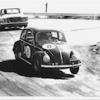Pressurising fuel tanks was a fairly common thing on old racecars. In hindsight it does seem weird as there is electric pumps and mechanical pumps that have been around for the best part of a century.
I can remember seeing Speedway midget and TQ drivers madly pumping in the 60s. Usually feeding SU or similar smooth bore carbs. They seldom ever had any engine problems though I do know of a few prangs happening while doing so.
AND not many years later a chap I know simply used a factory mechanical fuel pump to pressurise the tank. And that style of pump had been around for decades before. And he was feeding a supercharged Holden 6 with triple 2" SUs on methanol. A fairly large volume of fuel required. From memory 10 or 15sec on the starter would build enough pressure to start it. Though being methanol it was generally started cold with a spray of petrol to the intake.
I know of some midgets by that time were using a similar deal.
The only draw back is if a tank or line ruptures you have fuel everywhere wheras with a pump the engine stops and so does the pump. And I know that has happened.
I have seen clips of [I think] prewar racers pumping up the pressure. Some of the Jay Leno collection use the system and have manual pumps to pressurise for initial start.





















